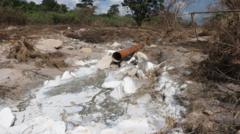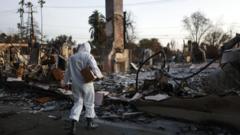A report by the American Lung Association reveals that approximately 46% of Americans are affected by unsafe air quality conditions, calling attention to the potential consequences of weakened environmental regulations.
Nearly Half of Americans Exposed to Unhealthy Air Quality, Report Reveals

Nearly Half of Americans Exposed to Unhealthy Air Quality, Report Reveals
The American Lung Association's latest report highlights significant air quality issues across the United States, indicating that around 156 million Americans live in areas with unhealthy pollution levels.
In a stark revelation, the American Lung Association’s annual State of the Air report indicates that around 156 million Americans, constituting nearly 46% of the population, are living with unsafe air quality due to ozone and particulate pollution. The report, released recently, criticizes plans by the Trump administration to relax environmental protections and reduce funding for air quality research, suggesting these changes would exacerbate existing health risks related to breathing polluted air.
Panagis Galiatsatos, a pulmonologist at Johns Hopkins School of Medicine, emphasized the importance of legislation for maintaining air quality, stating, “The biggest thing that has saved patients’ lives in regard to lung health and overall health is the Clean Air Act.” This highlights a broad consensus on the necessity of regulatory frameworks in safeguarding public health.
The report evaluated air quality data from 2021 to 2023, a timeline that included severe wildfire seasons in Canada, which contributed to significant air quality degradation in the U.S. While the Clean Air Act enacted in 1970 has led to improvements, with levels of key pollutants decreasing by nearly 80%, millions of Americans still face daily exposure to unhealthy air. Notably, over 156 million reside in areas that received a failing grade for at least one pollutant, while 42 million live in regions that failed to meet all three targeted pollutant standards. The data, drawn from 885 counties, shows 480 of those failed at least one pollution measure.
In light of these findings, health experts urge for renewed attention to air quality standards and advocacy for comprehensive policies that can further improve environmental conditions for affected populations.
Panagis Galiatsatos, a pulmonologist at Johns Hopkins School of Medicine, emphasized the importance of legislation for maintaining air quality, stating, “The biggest thing that has saved patients’ lives in regard to lung health and overall health is the Clean Air Act.” This highlights a broad consensus on the necessity of regulatory frameworks in safeguarding public health.
The report evaluated air quality data from 2021 to 2023, a timeline that included severe wildfire seasons in Canada, which contributed to significant air quality degradation in the U.S. While the Clean Air Act enacted in 1970 has led to improvements, with levels of key pollutants decreasing by nearly 80%, millions of Americans still face daily exposure to unhealthy air. Notably, over 156 million reside in areas that received a failing grade for at least one pollutant, while 42 million live in regions that failed to meet all three targeted pollutant standards. The data, drawn from 885 counties, shows 480 of those failed at least one pollution measure.
In light of these findings, health experts urge for renewed attention to air quality standards and advocacy for comprehensive policies that can further improve environmental conditions for affected populations.





















